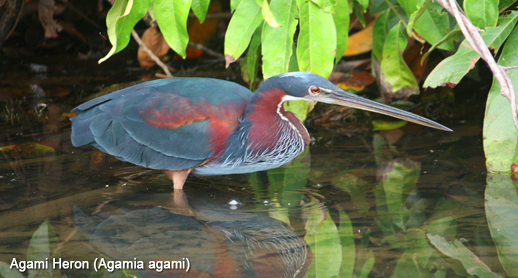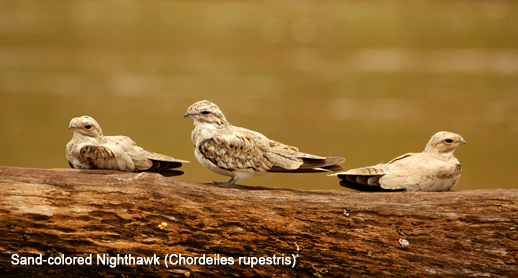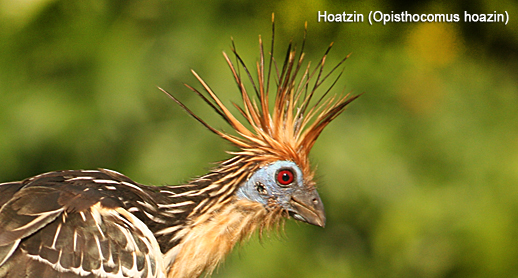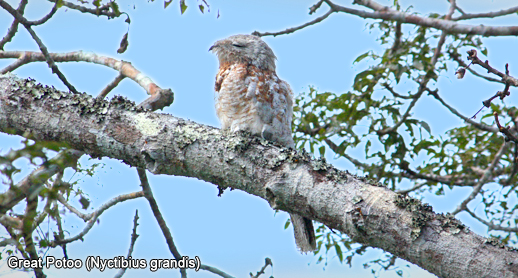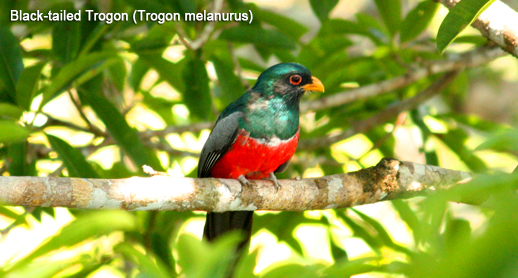BIRDWATCHING MACHUPICCHU AND MANU BIOSPHERE RESERVE 14 DAYS
Two Weeks Mega Birding
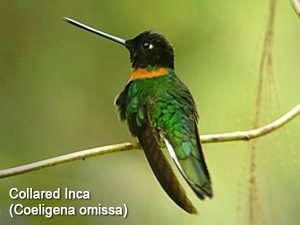 Manu Biosphere Reserve has the highest biodiversity of any protected area in the world. The unparalleled beauty of this trip is in the landscape and variety of habitats ranging from orchid-draped cloud forest where Spectacled Bears and Cock-of-the-Rocks still exist unbothered, to pristine Amazon rainforest with 13 primate species and oxbow lakes frequented by Giant Otters. A trip to Manu is a trip to one of the world´s great wilderness areas where wildlife is still plentiful and over 1000 species of birds have been recorded. Add to this a breathtaking visit to Machu Picchu and you have a trip of a lifetime.
Manu Biosphere Reserve has the highest biodiversity of any protected area in the world. The unparalleled beauty of this trip is in the landscape and variety of habitats ranging from orchid-draped cloud forest where Spectacled Bears and Cock-of-the-Rocks still exist unbothered, to pristine Amazon rainforest with 13 primate species and oxbow lakes frequented by Giant Otters. A trip to Manu is a trip to one of the world´s great wilderness areas where wildlife is still plentiful and over 1000 species of birds have been recorded. Add to this a breathtaking visit to Machu Picchu and you have a trip of a lifetime.
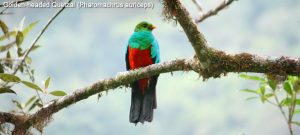
Day 0: Arrival
Depending on arrival time in Lima we either transfer to your hotel in Lima or connect to Cusco.
Day 01: Lima – Cusco – Aguas Calientes Town – Machupicchu
Depending on arrival time to Cusco, if is morning flight to Cusco, we direct departure to the field-Huacarpay Lakes. If not we transfer to Ollantaytambo- Aguas Calientes. From Cusco we are going to drive for two hours to Ollantaytambo town to take the evening train (two hours) to Aguas Calientes town. Night in Aguas Calientes . L.D. *Birding Huacarpay Lakes, here we will see a variety of high Andean waterfowl, wetland birds, and a selection of typical highland passerines. We will likely see the spectacular and endemic Bearded Mountaineer feeding in Tabaco flowering bushes near the lake. One of our main goals is to find the Bearded Mountaineer, a spectacular hummingbird restricted to just a few arid valleys. Other birds we may well encounter here are White-tufted Grebe, Puna Ibis, Yellow-Billed, Puna and Cinnamon Teals, Andean Duck, Cinereous Harrier, Plumbeous Rail, Andean Coot, Andean Lapwing, Andean Negrito, Andean Gull, the impressive Giant Hummingbird, Sparkling Violetear, Green-tailed Trainbearer, Andean Flicker, the endemic Rusty-fronted Canastero, Streak-fronted Thornbird, Many-colored Rush Tyrant, Wren-like Rushbird, White-browed Chat-Tyrant, Spot-billed Ground-Tyrant, Yellow-winged Blackbird, Greenish Yellow-Finch, and many more.
Day 02: Machupicchu to Cusco
Early morning for birding and visit to the Citadel of Machupicchu (2400m) lost city of the Incas is so well known from the numerous photographs and articles that feature this extraordinary place that it seems almost unnecessary to describe its dramatic setting amongst the Andes. The city is perched on a narrow ridge high above the Urubamba River and on seeing the precipitous slopes on all sides one can easily appreciate why it remained undiscovered for so many years. The area around Machupicchu has been cleared of forest and so scrub and bamboo thickets are now the predominant habitat, inhabited by the noisy endemic Inca Wren, although some forest patches can be found along the river valley. Other species we may find in the area include Mitred Parakeet, White-tipped Swift, Green-and-white Hummingbird, Collared Inca, Ocellated Piculet, Streaked Xenops, Variable Antshrike, Mottle-cheeked Tyrannulet, Rusty Flowerpiercer, Oleaginous Hemispingus, Yellow-bellied Seedeater, Hooded Siskin. Along the Urubamba River, where Torrent Duck and White-capped Dippers can regularly be seen along the fast flowing river.This afternoon we spent birding at the botanic garden. We may see: Green Hermit, Chestnut-breasted Coronet, Speckle-faced Parrot, Sclaterâs Tyrannulet,Glossy-black Thrush and the endemic Masked Fruiteater, Torrent Tyrannulet, Fawn-breasted Tanager, Saffron-crowned Tanager, Slaty Tanager, Silver-backed Tanager, Capped Conebill, Chestnut-capped Brush-Finch and Orange-bellied Euphonia. In the late afternoon we will return to Cusco. B.L.D.
Day 03: Cusco to Wayqecha Biological Station (2950m)
Today we will leave early, first driving and birding through scenic intermontane valleys . We will make selected stops for two smart endemics: Creamy-crested Spinetail and Chestnut-breasted Mountain-Finch. In addition, we may find Cinereous Conebill, Golden-billed Saltator, Band-tailed Seedeater, Peruvian and Ash-breasted Sierra-Finches. Reaching a high mountain pass at Acjanacu, we will begin our journey into a vast intact wilderness area as we descend along the sinuous road that will take us to the Manu foothills. Along the extraordinary altitudinal transect that this remarkable road represents, new bird species continually appear whilst others drop out. Initially, the steep Andean slopes are clad in stunted forest, temperate shrubbery and wet paramo, and here we may well encounter such high-elevation species as Mountain Caracara, Shining Sunbeam, Bar-winged Cinclodes, Puna Thistletail, Tufted Tit-Tyrant and Black-throated and Moustached Flower-piercers. A little lower down, where the magnificent cloudforests begin, we shall look out for White-throated and Variable Hawks soaring over the impressive slopes. With a little luck we will see a Swallow-tailed Nightjar this evening. We will stay for one night at the Wayqecha Biological Station. In upper Manu-cloudforest. L.D.
Day 05: Cock-of-the-rock Lodge (Lower Manu cloud forest 1400m)
Cock-of-the-rock Lodge, the Manu road the comfortable subtropical and lower temperate life zones with their spectacular avifauna: In a short distance is a lek of the Andean Cock-of-the-Rock. The most spectacular of the birds of paradise. The displays of these splendid birds and their unearthly strangled shrieks will be emblazoned in our memories for years to come. Near the lodge we shall search for such specialities as Black-billed Treehunter, Slaty Gnateater, Cinnamon-faced Tyrannulet, Versicoloured Barbet, Golden-olive Woodpecker, Olive-backed Woodcreeper, Montane Foliage-gleaner, Yellow-breasted Antwren, Streak-necked and Slaty-capped Flycatchers, Bolivian Tyrannulet, Marble-faced Bristle-Tyrant, Grey-mantled Wren, Andean and White-eared Solitaires, Brown-capped Vireo, Tropical Parula, Russet-crowned and Three-striped Warblers, Slate-throated Redstart, Deep-blue and Bluish Flower-piercers, Blue-naped Chlorophonia, Fawn-breasted, Orange-eared, Golden, Saffron-crowned, Yellow-throated and Slaty Tanagers, Yellow-throated and Common Bush-Tanagers, Dark-faced Brush-Finch, Golden-headed and Crested Quetzals and Hummingbirds such jewels as Violet-fronted Brilliant, Many-spotted Hummingbirds Speckled Hummingbird, Booted Rackettail and Long-tailed Sylph. and as the morning sun warms up the crisp air we shall scan the skies for these huge raptors: Solitary and Black-and-chestnut Eagles . Additional birds we may encounter here include Band-tailed Pigeon, Chestnut-collared Swift, Masked Trogon, Highland Motmot, Amazonian Umbrellabird, Yungas Manakin ,White-crowned Tapaculo, Cinnamon, Lemon-browed and Golden-crowned Flycatchers, Smoke-coloured Pewee, Green Jay, Grey-breasted Wood-Wren, Two-banded Warbler, Dusky-green Oropendola, Olivaceous Siskin and a dazzling array of tanagers.At nights we search for Rufescent Screech-Owl and Lyre-tailed Nightjar. Night in Cock-of-the-rock Lodge. B:L:D. NOTE: If Wayqecha and Cock-of-the-rock Logde are full weâll stay at the nearby very comfortable Paradise Lodge
Day 06: Lower Manu road to Amazonia Lodge
After a final morning in the birdy cloudforests we will descend further down the Manu road to the comfortable Amazonia Lodge, we shall scan the boulder-strewn rapids for Black Phoebe and White-capped Dipper. Most of the day will be spent birding the upper tropical forests of the foothills in search of such species as Military Macaw, Peruvian Piedtail, Chestnut-backed Antshrike, Stripe-chested Antwren, Black Antbird, Ornate Flycatcher, the localized Red-billed Tyrannulet and the delightful Black-backed Tody-Flycatcher. With a modicum of luck we will find an Amazonian Umbrellabird perched in a roadside tree. Cleared areas may produce Smooth-billed Ani, the odd-looking Swallow-Tanager, Blue-black Grassquit, Black-and-white and Chestnut-bellied Seedeaters, and Lesser Seed-Finch. During good weather, raptors often soar overhead and we shall keep an eye out for White Hawk and Black-and-white Hawk-Eagle in particular. Later we will cross the Alto Madre de Dios river to Amazonia Lodge, located at an elevation of 1750 ft (500 m). Our base for the next two nights stay. B:L:D.
Day 07: Amazonia Lodge 500m (1,750 feet)
Where the last low foothills of the Andes begin to flatten out into the vast Amazonian lowlands. The floodplain near the lodge is covered in second growth only a few decades old, while on the steep hillsides tall primary forest is found. While birding the varied habitats at the lodge we will see a very rich assortment of birds. Some species we will especially look for include Blue-headed Macaw, Rufous-crested Coquette, Bluish-fronted Jacamar, Chestnut-capped Puffbird, Fine-barred Piculet, Bamboo Antshrike, Black-backed TodyâFlycatcher, and Golden-bellied Warbler. we should get good views of most if not all of them. Such localized species as Fiery-capped Manakin and Johannesâs Tody-Tyrant can often be found here as well, and sometimes even the elusive Black-capped Tinamou can be seen. False Vervain flowers in the lodge garden attract a multitude of dazzling hummingbirds, with possibilities including Violet-headed Hummingbird, Blue-tailed and Sapphire-spangled Emeralds, Golden-tailed Sapphire and Amethyst Woodstar. Although the hummingbird feeder is usually dominated by the large Grey-breasted Sabrewing, patience should reward us with the lovely Gouldâs Jewelfront. Many birds can even be observed from the lodge porch, including the huge Boat-billed Flycatcher, the noisy Pale-legged Hornero and the skulking Plain-crowned Spinetail. Male Yellow-rumped Caciques engage in vocal imitations from their nesting trees while the bird table provides close-up views of several species of tanager. A small marsh provides shelter for secretive Blackish Rails, though we shall be fortunate if we get to see these vocal birds, while even harder to see is the small Uniform Crake, which prefers the undergrowth of dense swampy forest. While climbing up the primary forest-clad ridge that overlooks the lodge we may encounter the endemic Koepckeâs Hermit, the terrestrial Grey-throated Leaftosser in the dark understorey the Plain Antvireo, whilst lively mixed canopy flocks could hold Olivaceous and Ocellated Woodcreepers, Speckled Spinetail, Rufous-tailed Antwren, Spectacled Bristle-Tyrant, and Olive Tanager. We can try our luck with the nightbirds found in the vicinity of the lodge, such as Tawny-bellied Screech-Owl, Black-banded Owl, Common Potoo and Pauraque. Other birds we may find in this wonderful area include Undulated Tinamou, Speckled Chachalaca, White-eyed Parakeet, White-collared Swift, Amazonian Violaceous Trogon, Chestnut-capped Puffbird, Straight-billed Woodcreeper, Buff-throated Foliage-gleaner, Band-tailed Antbird, Amazonian Antpitta, Band-tailed Manakin, Yellow-crowned and White-lored Tyrannulets, Forest Elaenia, Long-tailed Tyrant, Dusky-capped, Short-crested, Social, Grey-capped and Streaked Flycatchers, Tropical Kingbird, White-winged Becard, Purplish Jay, House Wren, Black-billed Thrush, Solitary Cacique, Bananaquit, Spotted, Yellow-bellied, Blue-necked, Turquoise, Bay-headed, Palm and Blue-grey Tanagers, and Greyish and Buff-throated Saltators. If we are very fortunate we will find one of the more difficult and highly sought-after species of the area such as Buckleyâs Forest-Falcon, Long-tailed Potoo or Rufous-webbed Brilliant. Night at Amazonia Lodge. B:L:D.
Day 08: Parrot Clay Lick to Hummingbird Lodge
Early start to visit the small Parrot Clay Lick, 25 minutes downriver along the Madre de Dios river bank. We will see Chestnut-Fronted Macaw, Blue-Headed Macaw, Dusky-Headed Parakeet, White-Eyed Parakeet, Blue-Headed Parrot and Yellow-Crowned Parrot. Then we will board our motorized canoe that we will take us down the Madre de Dios river to Amazon Wildlife Center Lodge.. Today we shall continue our river journey, leaving behind the green ridges of the foothills as we delve deeper into the humid lowlands, Black Skimmers, Sand-coloured Nighthawks and the bizarre Orinoco Goose. Careful scanning of the river edge may reveal the awkward shape of a Great Black-Hawk, the flash of a Sunbittern or the reddish brown of a Capybara, the worldâs largest rodent. With just a little luck on our side we should also be able to spot the stately Razor-billed Curassow, a species driven to near-extinction in large parts of Amazonia but still reasonably common here. Raucous Blue-and yellow, Scarlet and Red-and-green Macaws float overhead, clothed in a riot of colours. Along the riverâs edge we shall search for roosting Ladder-tailed Nightjars in the dense grassy vegetation. Other birds we may see along the way (or during river travel further into the tour) include Neotropic Cormorant, Great and Snowy Egrets, Cocoi, Little Blue and Capped Herons, Wood Stork, the enormous Jabiru, Roseate Spoonbill, Horned Screamer, Muscovy Duck, Black, Turkey, Greater Yellow-headed and King Vultures, Plumbeous Kite, the exceedingly graceful American Swallow-tailed Kite, Crane, Roadside and Short-tailed Hawks, Black Caracara, Bat and Laughing Falcons, Grey-necked Wood-Rail, Pied Lapwing, Collared Plover, Large-billed and Yellow-billed Terns, Pale-vented Pigeon, Grey-rumped and Short-tailed Swifts, Fork-tailed Palm-Swift, Chestnut-fronted and Red-bellied Macaws, Cobalt-winged and Tui Parakeets, Ringed and Amazon Kingfishers, Swallow-wing, Bare-necked Fruitcrow, Drab Water-Tyrant, Little Ground-Tyrant, Brown-chested and Grey-breasted Martins, White-winged, White-banded and Southern Rough-winged Swallows, Violaceous Jay, Red-capped Cardinal, Yellow-browed Sparrow, Giant Cowbird, and Crested and Russet-backed Oropendolas. Eventually we will arrive at the comfortable Hummingbird Lodge for one night stay (No hot shower). B:L:D.
Day 09: Hummingbird Lodge to Amazon Wildlife Center
After some final birding at Hummingbird Lodge, We will drive downstream through the famous Madre de Dios River, for two hours boat ride. To our very comfortable Amazon Wildlife Center, rooms with a private toilet and shower facilities. Hot and cold water is always available and all toilets facilities are flush. 567 species of birds have been recorded here. Night at Amazon Wildlife Center, our base for 4 nights. B:L:D.
Day 10: Macaw Clay Lick & AWC Trails
We start early morning, 40 minutes downriver to the most spectalurar and the biggest Macaw Clay lick, this one featuring up to 100 Red-and-green Macaws and observe the spectacle of hundreds of Parrots and Parakeets very close from our blinds. Red-and-green Macaw is a highlight. Here we will see the beautiful Orange-cheeked Parrrot, Blue-headed Parrot as well as Mealy and Yellow-crowned Parrots. Smaller visitors include White-eyed, Cobalt-winged and Tui Parakeeks. This afeternoon we will bird the extensive trail systems which have been designed to visit different forest types. The area around this lodge has the most forest types of anywhere in the Manu area. Night at Amazon Wildlife Center. B:L:D.
Day 11: Blanco Oxbow Lake & Tapir Clay lick
We will also visit Blanco Oxbow Lake. Picking up species we may missed. Where we will see lakeside birds including Hoatzin, Sungrebe, Agami Heron, Black-billed Seed-finch, Silvered and Band-tailed Antbirds, Amazonian Streaked Antwren, Rufous-sided Crake, Gray-breasted Crake, amongst others and we may be lucky and see one of the two Giant Otter families that live in the area.We will visit the large Mammal Clay Lick in the forest, apart from attracting Tapirs, Peccaries and maybe a Jaguar, also attracts Guans, Currasows, Chachalacas as well as Rose-fronted and Rock Parakeets and Dusky-billed Parrotlet. Night at Amazon Wildlife Center. B:L:D
Day 12: Amazon Wildlife Center & Manaking Leks
Today we will be birding the extensive trail systems which have been designed to visit different forest types. The area around this lodge has the most forest types of anywhere in the Manu area, and thus the highest bio-diversity – which means the most species of birds. With the extensive Varzea, Tierra Firme and Mature Transitional Floodplain Forest, this means a mind-boggling variety of bird-life. We expect this lodge area to hold more species of birds than anywhere else in the world and the bird list is already 567. We will look for the Rufous-fronted Antthrush we have located on territory here. Some of the scarcer forest species we will be on the lookout for that we have seen here previously include : Bartlettâs Tinamou, Razor-billed Currasow, Pale-winged Trumpeter, Sunbittern, Elusive Antpitta Pavonine Quetzal, Purus Jacamar, Striolated Puffbird, Gray-cheeked Nunlet, Cream-colored Woodpecker, Ocellated Woodcreeper, Colared Puffbird, Ruddy Spinetail, Plain Softail, Striped Woodhaunter, Sclaterâs Antwren, Banded Antbird, Ash-throated Gnateater, White-throated Antbird, Black-spotted Bare-eye, Black-faced Cotinga, Ochre-bellied Flycatcher, White-bellied tody-tyrant, Royal Flycatcher, Musician Wren, Pale-eyed Blackbird, Yellow-shouldered Grosbeak to name but a few. Night birding may produce Long-tailed, Great and Common Potoos, Amazonian Pygmy Owl, Spectacled Owl, Ocellated Poorwill and Silky-tailed Nightjar amongst others. Optional another visit to the large mammal Clay lick in the forest, apart from attracting Tapirs, Peccaries and maybe a Jaguar, also attracts Guans, Currasows, Chachalacas as well as Rose-fronted and Rock Parakeets and Dusky-billed Parrotlet. Night at Amazon Wildlife Center. B:L:D
Day 13: Canopy Tower to Puerto Maldonado City
Early start to visit the canopy tower 38 m. From this lofty perch we shall be seeing birds in all directions, in addition canopy species, other possibilities here include, Rose-fronted Parakeet, White-necked Puffbird, White-browed Purpletuft, White-throated and Yellow-tufted Woodpeckers, Plum-throated and Spangled Cotingas, Crowned Slaty Flycatcher, Black-tailed and Black-crowned Tityras, Black-faced, Blue and Yellow-bellied Dacnises, White-lored Euphonia and Olive Oropendolas. Our journey down the Madre de Dios River. It will be a great chance to see riverside birds and raptors. As the journey continues weâll see evidence of gold mining. Leaving our boat. At Boca Colorado, weâll take a 4 hours bus ride, birding along the way to Puerto Maldonado where weâll stay at our comfortable Hotel. B:L:D.
Day 14: Puerto Maldonado to Lima
This morning we will bird near the airport and the road to Cusco which several species of widespread distribution have colonized in the wake of deforestation. We should pick up some new species in these few hours, including Double-collared Seedeater, Red-breasted Blackbird and possibly White-tailed Kite or Lesser Yellow-headed Vulture. Other birds we will look for include Southern Caracara, Gray-breasted Crake, Scaled Pigeon, Rusty-margined Flycatcher, Black-faced Tanager and Grassland Sparrow. Later we will take a midday flight, via Cusco, to Lima where the tours ends this afternoon. Soon after we leave Puerto Maldonado, and as we head towards the Andes, a green Amazonian wilderness reaches out towards the distant horizon. It is a sight to lift the spirits of anyone depressed by the endless news about the progressive destruction of our planet, for here nature still survives almost untouched, as we have just seen up close for ourselves. Night in Lima. B:
Day 15: flight home
TOUR INFORMATION 2022
PRICE: min. 2 passengers — based in double occupancy.
INCLUDED: All lodging, Meals, transpotation, Expert bilingual birdguide, Check list, Hotel transfer and entrance fees.
NOT INCLUDED: Does not include air Puerto Maldonado to Lima but we will purchase these on request, Airport tax & Personal expenses.
TRIP CONSIDERATIONS
CLIMATE: Hot and humid in the lowlands to very cold at Abra Malaga. In a dry season tour there is the possibilty of a «Friaje», a strong cold front moving up from the south that can bring periods of unusually cool weather and rain.
DIFFICULTY: Moderate. There are some long journeys and early starts, but the walking is usually fairly easy. The walk up to the Polylepis is optional, those not wishing to do the hike can stay with the bus.
ACCOMMODATION: The jungle lodges are comfortable but simple; some do not have full-time electricity, but provide a generator for a few hours a day to charge batteries. The hotels in Cusco, Ollantaytambo, Machu Picchu and Puerto Maldonado are Amazon Birding Standard. The hotel we use in Lima depends on flight schedules. Sometimes we use an airport hotel that is very convenient though a bit noisy, while other times we use a hotel in a better part of the city.
Bird Photography: Opportunities are worthwhile.
Linkable Amazon birding: Central & Northern peru
What to Bring
We advise you to bring:
- Aside from Binoculars and photo-equipment (the important birdwatchers stuff), we advise:
- A spotting scope, if you have one
- Flashlight for night birding
- Light day pack
- Sunscreen and insect repellent
- T-shirts and a long-sleeved shirt
- Jeans or other cotton pants are comfortable, as well as quick-drying nylon ones
- Cotton socks
- Sweater, jacket or fleece for night birding
- Light jacket, water resistant, or poncho
- Hiking boots or sturdy shoes
- Sandals for after hours
- Hat and sunglasses
- Plastic bags for camera, clothes, etc
- Personal toiletries (shampoo, towel, etc)
NOTE: In rainy season we provide umbrella and rubber boots in many popular sizes for rainy days.
Amazon Birding look forward to welcoming and guiding you soon!
Last minute bookings will be accepted but you must be aware that there is the possibility that we will not get space at the hotel or tour that you need.
PLEASE CHECK OUR SOUTHERN PERU BIRD LIST
PLEASE CONTACT US IF YOU HAVE ANY QUESTIONS OR CONCERNS.
AMAZON BIRDING: Conservation through bird-ecotourism.
PHOTOS GALLERY – BIRDING MANU & MACHUPICCHU

